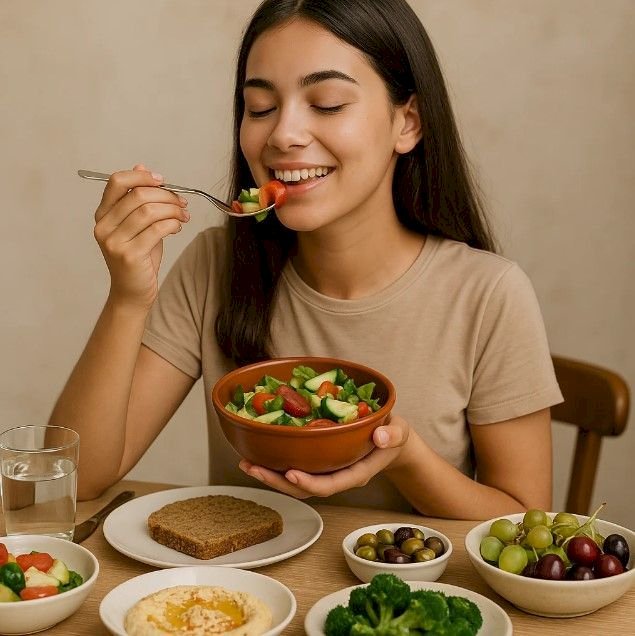Healthy Foods for Glowing Skin: Nutrient-Packed Choices to Eat Now
Discover 10 healthy foods for good skin that fight acne, boost glow, and slow aging. Simple U.S. diet tips for natural, radiant skin

Everyone wants clear, glowing skin, and while creams and serums can help, the truth is that what you eat matters just as much. The right diet provides your body with vitamins, minerals, and healthy fats that keep skin strong, hydrated, and youthful. According to the American Academy of Dermatology, nutrition plays a key role in reducing inflammation, supporting collagen, and protecting against environmental stressors. If you’ve been wondering how to improve your complexion naturally, the answer often starts in your kitchen. By choosing the right foods, you give your skin the building blocks it needs to repair, protect, and shine. ➤ In this article, we are going to explore healthy foods for good skin and how to add them to your diet today.
1. The Connection Between Nutrition and Skin Health
Your skin is your body’s largest organ, and just like your heart or brain, it needs proper nutrients to function well. Vitamins, antioxidants, and essential fats all work together to fight damage from the sun, pollution, and stress. For example, antioxidants like vitamin C help neutralize free radicals, unstable molecules that accelerate aging. Omega-3 fatty acids reduce inflammation, which can lower the risk of acne flare-ups and soothe redness. On the other hand, eating a diet high in refined sugars and processed fats can increase breakouts, dullness, and early wrinkles (NIH, 2023). Simply put: your skin is a reflection of what you eat.
2. Avocados: Creamy Goodness for Hydrated Skin
Avocados are packed with monounsaturated fats and vitamin E, two nutrients essential for skin barrier function. Vitamin E acts as an antioxidant, protecting against oxidative stress caused by UV exposure. One medium avocado provides nearly 20% of your daily vitamin E needs (USDA, 2024). Dermatologists often recommend avocados for people with dry or sensitive skin. In addition to salads and smoothies, try avocado as a healthy substitute for mayonnaise or butter. Eating half an avocado a few times per week can help keep skin moisturized and supple.
3. Fatty Fish: Omega-3s for Smooth and Clear Skin
Fatty fish such as salmon, mackerel, and sardines are rich in omega-3 fatty acids, which help maintain the skin’s lipid barrier and keep it hydrated. Research shows that omega-3s also reduce inflammatory markers that trigger acne and psoriasis (NIH, 2023). Fatty fish are also high in vitamin D, which supports skin cell repair. Experts recommend at least two servings of fatty fish per week (Dietary Guidelines for Americans, 2020–2025). If you don’t eat fish, chia seeds, flaxseeds, and walnuts are good plant-based sources.
4. Blueberries: Antioxidant Power for a Youthful Glow
Blueberries are rich in anthocyanins and vitamin C, both of which fight oxidative stress that contributes to wrinkles and uneven skin tone. Vitamin C is also crucial for collagen production, the protein that keeps skin firm and smooth. Just one cup of blueberries provides nearly a quarter of your daily vitamin C needs (USDA, 2024). Compared to high-sugar fruits, blueberries are also low on the glycemic index, making them less likely to cause breakouts. Adding them to smoothies, oatmeal, or yogurt is a delicious way to keep your skin protected and glowing.
5. Sweet Potatoes: A Natural Source of Beta-Carotene
Sweet potatoes are an excellent source of beta-carotene, which the body converts into vitamin A. Vitamin A helps regulate cell turnover and prevent dry, flaky skin. Beta-carotene also acts as a natural sunscreen by absorbing UV light and protecting skin cells from sun-related damage (NIH, 2022). Eating one medium sweet potato can provide over 100% of your daily vitamin A needs. Roast them, mash them, or slice into fries for a skin-friendly side dish.
6. Walnuts: A Crunchy Snack for Healthy Skin
Walnuts are unique among nuts because they contain both omega-3 and omega-6 fatty acids, along with zinc, a mineral essential for wound healing and acne prevention. Zinc helps regulate oil production and supports the immune response in skin tissue. Just one ounce (a small handful) provides almost half of the daily recommended intake of omega-3 ALA (alpha-linolenic acid). Snack on walnuts, add them to oatmeal, or sprinkle on salads for a crunchy, skin-boosting upgrade.
7. Tomatoes: Lycopene for Sun Protection
Tomatoes are one of the best sources of lycopene, a carotenoid that gives them their red color. Lycopene has been shown to improve the skin’s natural defense against UV damage and sunburn sensitivity (AAD, 2023). Cooking tomatoes enhances lycopene absorption, so tomato sauce or soup may be even more beneficial than raw tomatoes. They’re also rich in vitamin C, making them a dual powerhouse for collagen support and wrinkle prevention.
8. Green Tea: A Calming Drink for Clear Skin
Green tea is loaded with catechins, antioxidants that help reduce inflammation, redness, and even sun damage. Some studies show that green tea can improve skin elasticity and hydration when consumed regularly (NIH, 2021). Drinking one to two cups a day provides steady antioxidant support. Matcha, a powdered form of green tea, contains even higher concentrations of catechins. For those sensitive to caffeine, decaf green tea retains most of the skin-healthy compounds.
9. Bell Peppers: Vitamin C Powerhouses
One cup of bell peppers provides over 150% of your daily vitamin C needs (USDA, 2024). This vitamin supports collagen synthesis, which is essential for reducing fine lines and improving elasticity. The carotenoids in bell peppers also offer extra antioxidant protection, particularly lutein and zeaxanthin, which support skin and eye health. Incorporating raw peppers into snacks or cooked dishes helps ensure you’re meeting your daily vitamin C intake.
10. Dark Chocolate: A Sweet Treat with Benefits
Cocoa is naturally rich in flavanols, plant compounds that improve circulation and hydration in the skin. A study published in The Journal of Nutrition found that participants who consumed flavanol-rich cocoa had smoother, thicker skin compared to those who did not. To get the most benefits, choose dark chocolate with at least 70% cocoa content and limit intake to 1–2 ounces a few times per week. Avoid milk chocolate, which is high in sugar and low in beneficial compounds.
If you enjoy adding creativity to your kitchen, you might also love our complete guide on using a sugar cookie decorating kit to make festive treats.
11. Spinach: A Leafy Green for Skin Strength
Spinach contains vitamin A (retinol), vitamin C, folate, and iron. Vitamin A helps regulate oil production, which reduces acne, while vitamin C supports collagen. Iron enhances circulation and oxygen delivery to the skin, giving it a brighter appearance. One cup of cooked spinach also provides around 25% of your daily vitamin A requirement (USDA, 2024). For maximum benefits, combine spinach with a healthy fat like olive oil to boost absorption of fat-soluble vitamins.
12. Almonds: Vitamin E-Rich Skin Protectors
Almonds are one of the richest natural sources of vitamin E, an antioxidant that helps neutralize UV damage and maintain skin elasticity. Vitamin E also supports the function of vitamin C, making them a perfect nutritional pair. A one-ounce serving of almonds provides nearly 50% of the recommended daily intake of vitamin E. Enjoy them raw, roasted, or added to oatmeal and salads for an easy skin-friendly snack.
13. Cucumbers: Nature’s Hydration Booster
Cucumbers are more than 90% water, making them excellent for hydration. They also contain silica, a trace mineral important for skin elasticity and connective tissue health. While cucumber slices are famous for reducing puffiness around the eyes, eating cucumbers helps maintain hydration throughout the body. Add them to infused water, salads, or wraps for refreshing support to your daily hydration goals.
14. Oranges: Citrus Support for Collagen
Oranges are a vitamin C powerhouse, supporting both collagen production and immune function. The combination of hydration, antioxidants, and fiber makes oranges especially effective for skin clarity and repair. Eating one orange provides more than 100% of your daily vitamin C needs (USDA, 2024). For variety, try grapefruit, kiwi, or strawberries—all excellent vitamin C alternatives.
15. Greek Yogurt: Probiotics for Skin Balance
Greek yogurt delivers probiotics that balance gut bacteria, which in turn influences skin health. An imbalanced gut microbiome has been linked to acne and inflammation (AAD, 2023). Yogurt is also high in protein, supporting cell growth and repair. For the best results, choose plain, unsweetened Greek yogurt to avoid added sugars. If you’re lactose-sensitive, opt for plant-based probiotic foods like sauerkraut, kimchi, or kefir.
16. Carrots: Beta-Carotene for Radiant Skin
Carrots are loaded with beta-carotene, which converts to vitamin A in the body. Vitamin A is essential for healthy cell turnover, which keeps skin smooth and glowing. Carrots also provide antioxidants that protect against environmental stressors. Eating just one cup of chopped carrots meets 100% of the daily vitamin A requirement (USDA, 2024). Snack on raw carrots, blend into smoothies, or cook into soups for a skin-friendly boost.
17. Best Foods for Common U.S. Skin Concerns
- Acne: Omega-3 fatty acids (salmon, walnuts), probiotics (yogurt, kefir).
- Dryness: Avocado, olive oil, cucumbers.
- Wrinkles & Aging: Blueberries, green tea, tomatoes.
- Dark Spots / Hyperpigmentation: Vitamin C-rich foods like oranges, kiwi, bell peppers.
Matching foods to your specific skin concern can speed results and make your diet more targeted.
18. A Sample Daily Meal Plan for Glowing Skin
- Breakfast: Greek yogurt with blueberries and almonds.
- Lunch: Salmon and spinach salad with avocado.
- Snack: Carrot sticks with hummus or a handful of walnuts.
- Dinner: Grilled chicken with roasted sweet potatoes, bell peppers, and tomatoes.
- Evening: One square of dark chocolate and a cup of green tea.
This balanced plan combines antioxidants, healthy fats, and hydration to support glowing skin.
Top Nutrients and Their Food Sources for Skin Health
|
Nutrient |
Benefits for Skin |
Best U.S. Sources |
|
Vitamin C |
Collagen support, brightens skin |
Oranges, bell peppers, kiwi |
|
Vitamin E |
Protects against UV damage |
Almonds, avocados |
|
Vitamin A (beta-carotene) |
Cell repair, reduces dryness |
Carrots, sweet potatoes |
|
Omega-3 fatty acids |
Reduce inflammation, hydrate |
Salmon, walnuts, chia seeds |
|
Probiotics |
Balance gut and skin |
Greek yogurt, kefir |
Source: USDA Dietary Guidelines & American Academy of Dermatology, 2024–2025
19. U.S. Nutrition Gaps and Skin Health
USDA surveys show that 9 out of 10 Americans don’t eat enough fruits and vegetables daily. Similarly, omega-3 intake is often well below recommended levels (USDA, 2024). These gaps directly affect skin health, leading to issues like dullness, dryness, and faster aging. Adding even one extra serving of vegetables or a weekly fish-based meal can close these gaps and visibly improve skin over time.
20. Lifestyle Factors That Work with Nutrition
Healthy skin requires more than food alone. Hydration, sun protection, sleep, and stress management are equally important. Drinking water enhances the effects of hydrating foods like cucumbers. Wearing sunscreen plus eating antioxidant-rich foods like tomatoes reduces UV aging. Getting 7–9 hours of sleep each night allows your body to repair skin cells. Managing stress lowers cortisol, a hormone linked to breakouts. Together, these habits maximize the impact of a skin-friendly diet.
21. Extra Foods That Deserve a Place on Your Plate
- Kiwi: Higher in vitamin C than oranges.
- Pomegranates: Hydrating and antioxidant-rich.
- Olive Oil: Healthy fats and polyphenols for reduced inflammation.
- Legumes: Plant-based zinc and protein for skin repair.
These foods expand variety while providing targeted nutrients for skin clarity and strength.
Estimated U.S. Spending on Skin Care vs. Food-Based Nutrition (2025)
|
Category |
Average Monthly Spending (U.S.) |
|
Skincare Products (creams, serums, etc.) |
$120 |
|
Dermatology Visits & Treatments |
$85 |
|
Healthy Skin-Focused Foods |
$60 |
Source: U.S. Health & Nutrition Market Report, 2024–2025
Read: If you’re looking for meal ideas that not only support glowing skin but also taste amazing, check out our guide on Healthy Asian Food Recipes: Nourishing & Flavorful Dishes Better Than Takeout.
Conclusion
Your skin’s health is deeply tied to what you eat every day. Foods like avocados, fatty fish, blueberries, and leafy greens provide essential nutrients that protect, repair, and give your skin a natural glow. Supporting your skin from the inside out is far more sustainable than relying only on creams. These healthy foods for good skin also boost overall health, so the benefits extend beyond appearance. Start small, be consistent, and your skin will thank you.
FAQs
What are the best vitamins for skin health?
The key vitamins are A, C, E, and D. They support collagen production, reduce oxidative stress, and aid repair (NIH, 2023).
Can diet really improve acne?
Yes. Studies show omega-3 fatty acids, zinc, and probiotics can reduce inflammation and breakouts, while diets high in sugar worsen acne (AAD, 2023).
How fast can I see results from eating healthy foods for good skin?
Most people notice improvements within 4–6 weeks, but long-term results require consistent healthy eating.
Are supplements better than whole foods for skin health?
Whole foods are best because they contain fiber and multiple nutrients. Supplements may help with deficiencies but should not replace food.
What foods should I avoid for better skin?
Highly processed foods, sugary snacks, and fried meals increase inflammation and can worsen acne or premature aging.

 Selina Smith
Selina Smith 

![Top 5 Brunch Dishes to Try at Stateside Kitchen Nashville [2025 Guide]](https://statesidemagazine.com/uploads/images/2025/05/image_380x226_68147889f1053.jpg)













